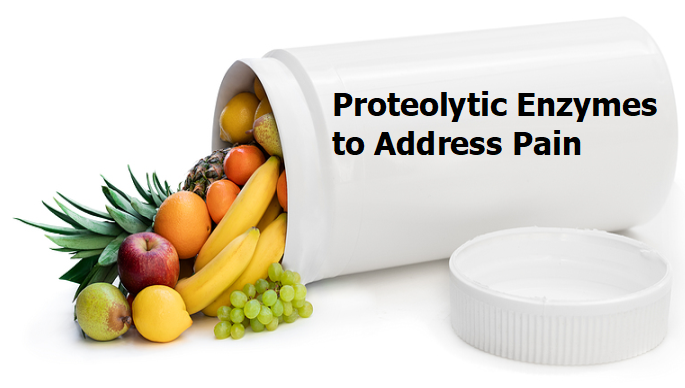Most people have never heard of using proteolytic enzymes to address pain, especially arthritic pain. This creates three key questions:
-
What are Proteolytic Enzymes?
-
Are proteolytic enzymes effective is addressing arthritic pain?
-
How to increase your body’s ability to create proteolytic enzymes?
Let’s start with the first question. Proteolytic enzymes are used by your body to break down and digest proteins. Sometimes they are referred to as peptidases, proteases, or proteinases.
In your body, these proteolytic enzymes are produced by your pancreas and stomach. They provide the following health benefits:
-
Digestion of proteins to improve overall digestion
-
May aid in reducing Irritable Bowel Syndrome and Inflammatory Bowel Disease
-
Helps to reduce muscle soreness
-
May have cancer-fighting properties
-
Effective in decreasing inflammation
-
May facilitate healing and speed recovery
-
Help to reduce pain
As you can see there are a lot of health benefits to this key group of enzymes. But the one we want to focus on is using proteolytic enzymes to address pain, especially arthritic pain.
According to the Center for Disease Control, there are over 54 million people that have arthritis. This is almost 25% of the adult population. And while there are several forms of arthritis, what is common to all of them is:
Chronic Inflammation and Fibrin!
In one of my previous articles, I discussed five food choices that contribute to chronic inflammation. The top three are:
-
Sugar
-
Gluten Containing Foods (anything with modern day wheat)
-
Processed Foods
For most of America, these three are consumed on a daily basis. All of them create inflammation in your body. Because they are eaten daily, the result is chronic inflammation.
What most people don’t understand is that chronic inflammation causes tissue damage. This tissue damages causes our body to produce a tough protein substance called fibrin.
Chronic inflammation results in excessive fibrin, which is a contributing factor in arthritic pain.
Which brings us to the second question:
Are proteolytic enzymes effective in addressing arthritic pain?
And the answer is “yes” for most people. When we are young our body naturally produces a large amount of proteolytic enzymes to help keep our joints healthy and free from fibrin.
But as we age our ability to create these proteolytic enzymes decrease. Part of the reason why is the pancreas doesn’t produce them at the same rate as when we were young. Additionally, our diet can affect this process, which we’ll talk about when we answer the third question.
Using proteolytic enzymes to address pain focuses on two main benefits:
Benefit #1 is the ability to decrease inflammation. Multiple studies have shown how proteolytic enzymes are effective in reducing inflammation. One type of proteolytic enzyme called bromelain has been shown to be effective in reducing pain, joint stiffness, and swelling in those who suffer from osteoarthritis.
These proteolytic enzymes also promote wound healing and help to accelerate new tissue growth.
Benefit #2 is how proteolytic enzymes break down fibrin. According to Dr. Max Wolf, proteolytic enzymes:
-
Break down protein in the blood that causes inflammation.
-
Removes fibrin, the clotting material that prolongs inflammation.
-
Helps to clear up edema (excess water) in the inflammation area.
Proteolytic enzymes eat fibrin and other scar tissue, which brings us to our final question:
How to increase your body’s ability to create proteolytic enzyme?
And the best way to do this is to eat foods that contain these types of enzymes. Two of the best sources are papaya and pineapple. Papaya contains the enzyme called papain. This powerful proteolytic enzyme has been used for thousands of years as a meat tenderizer because of its ability to break down protein.
Pineapples contain bromelain, which has been used by various cultures to address pain and inflammation, especially arthritic pain.
The following are also excellent sources for proteolytic enzymes:
-
Turmeric Extract
-
Devil’s Claw
-
Boswellia Extract
-
Ginger Extract
-
Rutin – which is a flavonoid
-
Citrus Bioflavonoids
If you don’t want to eat foods that contain these enzymes, or add them to your meal, then you can find supplements that contain these 8 key sources of proteolytic enzymes to address pain.
Just make sure the supplement comes from a reputable brand that tests their products for potency and quality.
Finally, we need to discuss safety and potential side effects. For most people proteolytic enzymes are considered safe. But because they are used to break down proteins they can have some side effects, especially if you’re adding them to your diet. This could include diarrhea and nausea.
For some there might be an allergic reaction or rash.
Some proteolytic enzymes may interfere with certain blood thinning medications. Because of this, it is always wise to consult with your physician and/or pharmacist to see if there are any drug interactions that you need to be aware of.
If you use proteolytic enzymes to address pain, then always start slow and gradually build up. And once you have experienced improvements, then you can back down to find the level that helps you maintain good health. And be free of the nagging pain associated with arthritis.
Blessing Lives Through Nitric Oxide Therapy!
Dan Hammer

Leave a Reply
You must be logged in to post a comment.